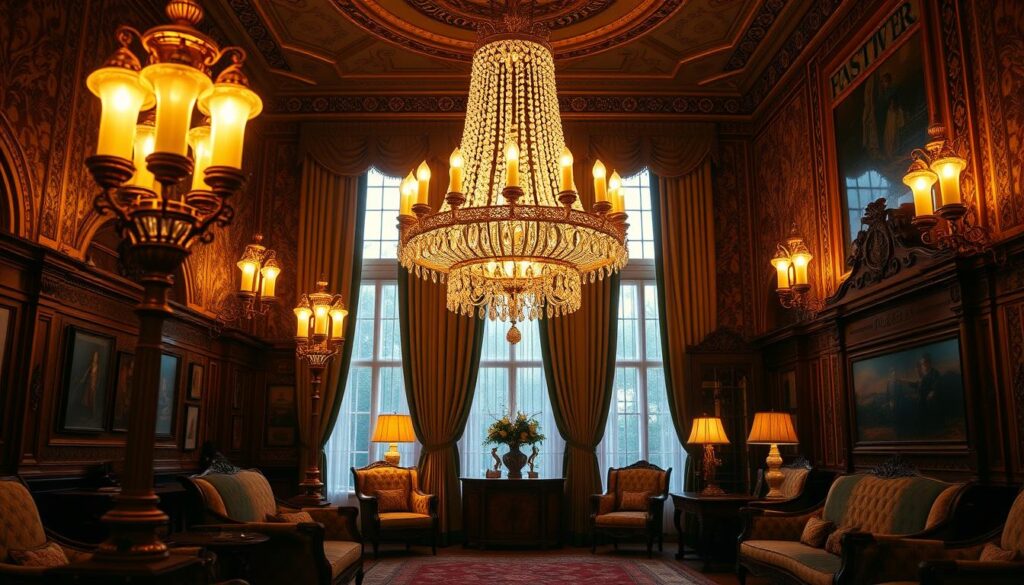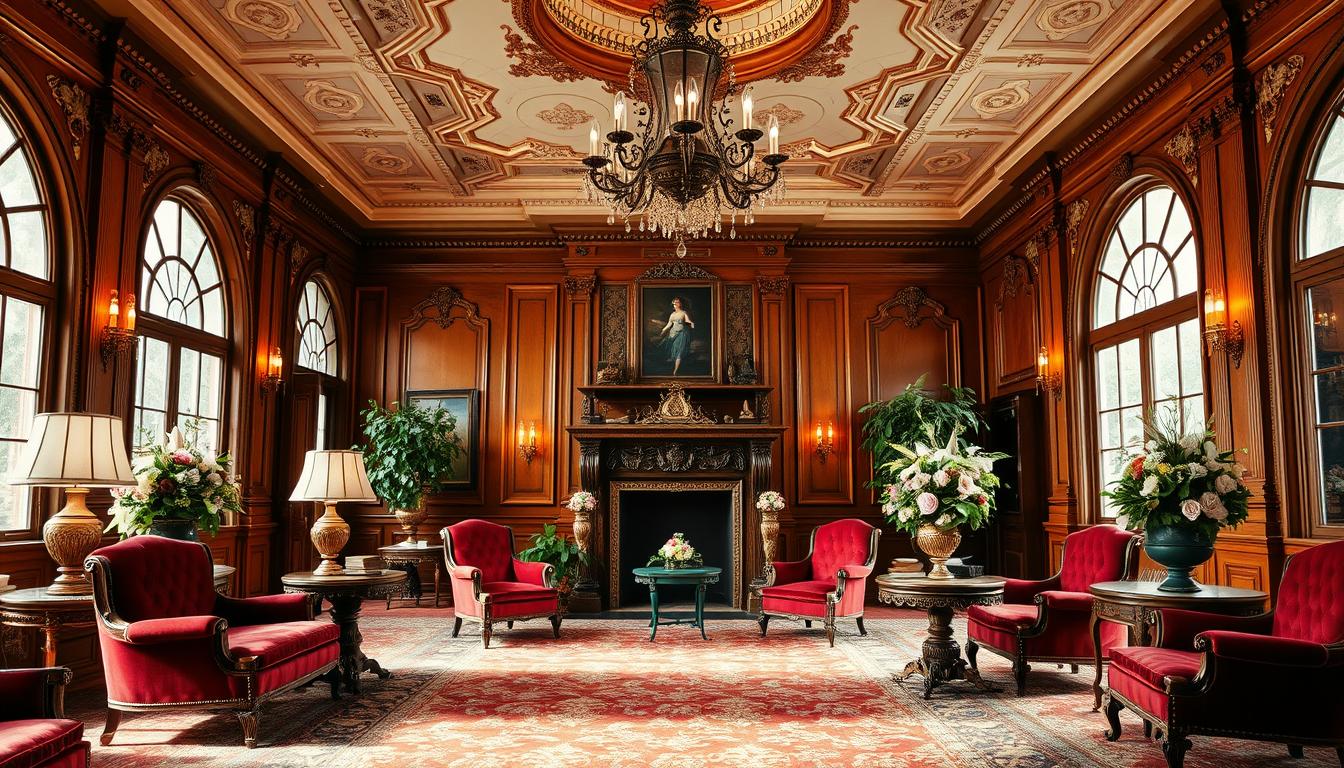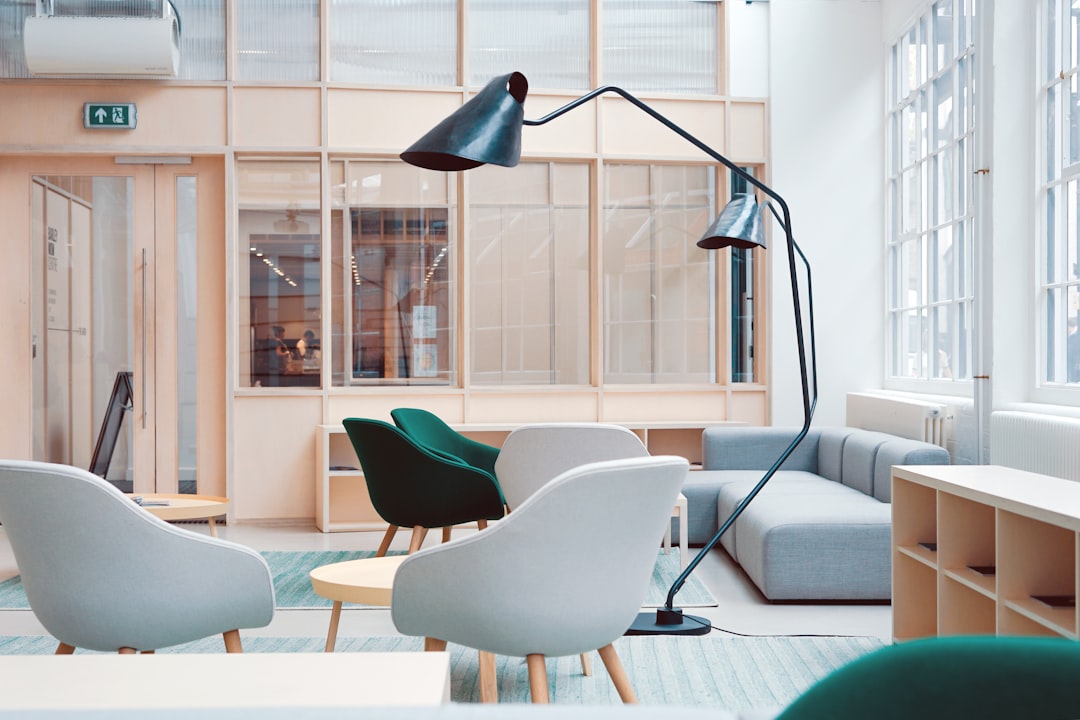The Victorian era brought a unique look, full of luxury and grandeur. This time, from the late 1830s to the early 1900s, saw the rise of detailed design elements. These elements made the era’s interiors stand out.
In this world, rich textures, complex patterns, and fancy furnishings rule. The heart of this design style is its ability to bring luxury and elegance. It’s a choice that never goes out of style for those who love its beauty.
Key Takeaways
- Victorian interior design is characterized by opulence and grandeur.
- The era’s interiors featured intricate design elements.
- Rich textures and complex patterns are hallmarks of the style.
- The aesthetic evokes a sense of luxury and refinement.
- It remains a timeless choice for those who appreciate its beauty.
Understanding Victorian Interior Design
Victorian interior design is more than a style; it shows the culture and values of the Victorian era. It emerged during Queen Victoria’s reign. This style is known for its opulence, grandeur, and detailed attention.
Key Characteristics of the Style
The Victorian style is famous for its rich colors and intricate patterns. These elements, combined with luxurious materials, make spaces warm and inviting. Key features include:
- Ornate furnishings and decorative accessories
- Rich, bold color schemes
- Intricate patterns and textures
- Luxurious materials such as velvet, silk, and mahogany
Popular Color Palettes
Victorian interiors often use bold, rich colors. Deep reds, emerald greens, and navy blues are common. These colors, along with gold and metallic accents, are used in walls and furniture to create a luxurious look.
Choosing the right color palette is key in period style decorating. It’s not just about picking popular Victorian colors. It’s about using them to create a harmonious, authentic Victorian atmosphere.
Materials and Textures
The Victorian style is known for its use of luxurious materials and textures. Velvet, silk, and mahogany add depth and interest to rooms. Different textures, like the smoothness of silk and the roughness of wood, enhance the space’s feel.
To use these elements well, you need to know how to mix materials and textures. For example, combining smooth surfaces with intricate patterns creates a beautiful contrast typical of Victorian decor.
Historical Context of Victorian Design
The Industrial Revolution was key in shaping Victorian design. This era was known for its opulence and grandeur. It was influenced by new technologies and societal changes.
The Influence of the Industrial Revolution
The Industrial Revolution changed interior design. New technologies and materials led to mass production. This made Victorian interiors unique.
The Industrial Revolution also changed how people lived. Cities grew, and urban lifestyles became common. This led to new interior design styles that were both functional and beautiful.
Notable Victorian Designers
Many designers shaped Victorian design. William Morris and Charles Eastlake were key figures. Morris focused on handmade goods and art in daily life. Eastlake pushed for simpler, honest design.
| Designer | Contribution | Influence on Victorian Design |
|---|---|---|
| William Morris | Arts and Crafts Movement | Emphasized handmade goods and art in everyday life |
| Charles Eastlake | Advocacy for simpler design | Influenced furniture and decor towards honesty and simplicity |
| A.W.N. Pugin | Gothic Revival Architecture | Shaped the architectural and interior design landscape |
Designers like Morris and Eastlake defined Victorian design. Their work showed the values and technology of their time. It still influences interior design today.
Essential Elements of Victorian Interiors
Victorian interiors are known for their luxury and grand style. They feature detailed designs and high-quality materials. This era’s love for beauty and skill is seen in every part of its design.
Furniture Styles and Features
Victorian furniture stands out with its detailed carvings and plush seats. Rich woods like mahogany and walnut were used, often with complex designs. Ornate carvings and gilded accents added to the luxury.
The furniture was not just for use but also to show wealth and status. It often had marquetry and inlay work, showing the skill of the time. Velvet, silk, and other fine fabrics were used for upholstery, adding to the luxury.
| Furniture Style | Characteristics | Materials |
|---|---|---|
| Victorian Sofas | Ornate carvings, tufted upholstery | Mahogany, velvet |
| Armchairs | Gilded accents, intricate patterns | Walnut, silk |
| Coffee Tables | Carved legs, marble tops | Oak, marble |
Decorative Accessories
Decorative accessories were key in Victorian interiors, adding texture and interest. Items like vases, candelabras, and mirrors were both useful and decorative. Porcelain and ceramics were favorites, often displayed on shelves or mantels.
Rugs and tapestries brought more patterns and colors, making the space cozy and welcoming. These elements helped create a warm, inviting feel, typical of Victorian homes. Choosing and placing these accessories carefully can bring an authentic vintage look to your space.
Color Schemes for Victorian Spaces
Rich tones and patterns are key in Victorian design. Choosing the right color scheme is vital to capture this style’s essence. The Victorian color palette combines bold, rich tones with subtle, muted shades for a unique look.
When picking a color scheme for a Victorian-inspired space, balance is key. Mix bold colors with softer tones for a harmonious look. This balance adds contrast and depth to the space.
Emphasizing Rich Tones
Rich tones are a hallmark of Victorian interior design. Deep reds, emerald greens, and navy blues were favorites back then. These bold colors can be used on walls, furniture, and accessories for a cohesive, opulent look.
To add rich tones to your Victorian-inspired space, try these color combinations:
| Color Combination | Description |
|---|---|
| Deep Red and Gold | A classic Victorian combination that exudes luxury and sophistication. |
| Emerald Green and Cream | A refreshing and elegant palette that brings a sense of calm to a room. |
| Navy Blue and White | A timeless and versatile combination that works well in both formal and informal settings. |
Integrating Patterns
Patterns were crucial in Victorian design, adding texture and interest. To include patterns in your color scheme, mix different textures and patterns. This could be stripes, florals, and geometrics, all in harmony.
For instance, pair a bold, striped wallpaper with a floral patterned rug and solid-colored furniture. This creates a layered, visually appealing look. The goal is to balance patterns and textures while keeping a cohesive color scheme.
By focusing on rich tones and patterns, you can make a Victorian-inspired space elegant and striking. Whether you’re restoring an antique home or adding Victorian touches to your modern space, a well-chosen color scheme is key to capturing this iconic style.
Patterns, Prints, and Textiles
Patterns, prints, and textiles are key in Victorian decor. They make spaces cozy and inviting, defining the period style. The Victorian era loved rich fabrics, showing off the homeowner’s status.
Common Patterns in Victorian Decor
Victorian interiors had many patterns, like florals, stripes, and damask. Floral patterns were big, showing off detailed flowers. They were on wallpaper, upholstery, and curtains, adding depth.
Stripes were used to make rooms look taller or wider. Damask patterns, with their fancy designs, brought sophistication.
Choosing the Right Fabrics
Picking the right fabrics is key for a true Victorian look. Velvet, silk, and heavy cotton were favorites. Velvet was used for fancy upholstery and curtains.
Think about texture, pattern, and color when picking fabrics. Victorian decor loved rich colors and detailed patterns. Mixing textures and patterns makes a space interesting and layered.
In summary, patterns, prints, and textiles are essential in Victorian interior design. Knowing the era’s patterns and choosing the right fabrics helps create a space full of opulence and coziness.
Lighting in Victorian Design
In Victorian design, lighting was more than just a need; it was an art form. It made any room feel warmer, more elegant, and sophisticated.
Lighting fixtures from that time were varied, from gas lamps to fancy candelabras. These were not just for light; they were also decorative, showing off the era’s love for luxury and detail.
Types of Lighting Fixtures
Victorian homes had many lighting fixtures, each with its own charm and purpose. Some of the most notable include:
- Gas Lamps: Gas lamps were a key feature, offering a warm, bright light. They were often decorated with intricate designs, enhancing the room’s look.
- Candelabras: Candelabras were popular, adding elegance and refinement to dining and parlors.
- Oil Lamps: Oil lamps provided a soft, warm light, used in living rooms and bedrooms.

Incorporating Natural Light
Natural light was also vital in Victorian design. Large windows, often with heavy drapes, let in plenty of light during the day. To use natural light well:
- Maximize Window Space: Make sure windows are clear of furniture and drapes to let in more light.
- Use Mirrors: Place mirrors opposite windows to reflect light, making rooms brighter and more open.
- Choose Light Colors: Light colors on walls and ceilings help reflect natural light, making rooms brighter.
By mixing artificial lighting with natural light, homes can feel warm and welcoming. This approach honors Victorian design. Whether you’re fixing up an old home or adding Victorian touches to a new one, good lighting is key.
Room-by-Room Guide to Victorian Design
Creating a Victorian-style home is more than just picking furniture. It’s about making every room feel special. We’ll guide you through Victorian interior design to turn your spaces into luxurious havens.
Living Room Essentials
The living room is the heart of the home. In Victorian design, it’s where luxury meets comfort. Use rich, dark colors and luxurious fabrics to set the mood. Choose ornate furniture, like carved sofas and armchairs, and highlight statement lighting like chandeliers.
Look for furniture with elaborate carvings and upholstery. Velvet sofas, tufted ottomans, and patterned armchairs are key. Decorate with vases, candelabras, and framed art to finish the look.
Dining Room Inspirations
The dining room is for formal gatherings, needing elegance and sophistication. Start with a large, ornate dining table and high-backed chairs with carvings. Use rich, dark woods and luxurious fabrics for upholstery and drapes.
Add candelabras and dimmable lighting for ambiance. Fine china, crystal glassware, and silverware make meals feel special.
Bedroom Styling Tips
Victorian bedrooms are cozy and private, with soft, muted colors and heavy drapery. A four-poster bed or ornate headboard is key. Add plush carpets and comfy seating for a cozy feel.
For a Victorian look, use delicate lace, intricate patterns, and luxurious textiles. Layer bedding and add plenty of pillows for depth and interest.
Tips for Incorporating Victorian Design Today
Bringing Victorian interior design into today’s homes needs careful thought. We must balance keeping the old charm with adding modern touches. This ensures our homes feel both rich in history and up-to-date.
Modern Takes on Classic Elements
To mix Victorian style with today’s homes, start with vintage pieces. Look for items like carved furniture or fancy lighting. Then, add modern decor to make your space stand out.
- Use vintage interiors as a statement piece, like an antique armchair or a classic chandelier.
- Incorporate period style decorating techniques, such as layering patterns and textures, to add depth to your space.
- Mix modern materials and designs with traditional Victorian elements to create a captivating contrast.
For example, pair a vintage sofa with a modern coffee table. This mix adds character to any room. Also, combining modern lights with Victorian designs can make a space feel cozy and elegant.
Balancing Old and New
It’s key to balance old and new when adding Victorian design to modern homes. We aim for a mix that respects both styles.
- Start with a neutral base that allows vintage pieces to stand out.
- Gradually introduce Victorian elements, ensuring they complement the existing decor.
- Use modern accessories to enhance the vintage pieces and prevent the space from feeling overly antique.
By carefully combining vintage and modern elements, we can create a unique look. This look honors Victorian design while meeting today’s tastes.
Maintaining Victorian Interiors
Keeping Victorian-era homes and furnishings beautiful needs careful attention. It’s important to know how to preserve antique interior design. This is crucial for those who own these historical homes.
Restoring Antique Pieces
Restoring antique furniture requires understanding Victorian-era materials and methods. Using traditional craftsmanship and materials keeps these pieces authentic. This ensures they remain valuable parts of our historical home design.
Regular Upkeep
Regular maintenance is key to keeping Victorian interiors beautiful. This includes dusting and polishing furniture, cleaning moldings, and checking for wear or damage. By doing these tasks, we can enjoy our antique interior design for years.
Combining preservation techniques with regular upkeep helps keep Victorian interiors opulent and charming. This way, our historical home design will live on for future generations.



